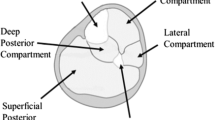Abstract
Vascular causes of exertional lower extremity pain are relatively rare, but may be the answer in athletes refractory to treatment for the more common overuse syndromes of the lower extremities. It is important to differentiate these vascular causes from chronic exertional compartment syndrome (CECS), medial tibial stress syndrome (MTSS), and stress fractures in order to develop appropriate treatment plans, avoid complications, and return athletes to play expeditiously. Important vascular etiologies to be considered are popliteal artery entrapment syndrome (PAES), endofibrotic disease, popliteal artery aneurysm, cystic adventitial disease, and peripheral arterial dissections. The diagnostic workup involves angiography or noninvasive vascular studies such as Doppler ultrasound or magnetic resonance angiography in both the neutral and provocative positions. Treatment of these vascular abnormalities typically involves surgical correction of the vascular anomaly.
Similar content being viewed by others
References and Recommended Reading
Wilder RP, Sethi S: Overuse injuries: tendinopathies, stress fractures, compartment syndrome, and shin splints. Clin Sports Med 2004, 23:55–81.
Blackman PG: A review of chronic exertional compartment syndrome in the lower leg. Med Sci Sports Exerc 2000, 32(Suppl):S4–S10.
Pedowitz RA, Hargens AR, Mubarak SJ, Gershuni DH: Modified criteria for the objective diagnosis of chronic compartment syndrome of the leg. Am J Sports Med 1990, 18:35–40.
Verleisdonk EJ, Schmitz RF, van der Werken C: Long-term results of fasciotomy of the anterior compartment in patients with exercise-induced pain in the lower leg. Int J Sports Med 2004, 25:224–229.
Kortebein PM, Kaufman KR, Basford JR, Stuart MJ: Medial tibial stress syndrome. Med Sci Sports Exerc 2000, 32(Suppl):S27–S33.
Thacker SB, Gilchrist J, Stroup DF, Kimsey CD: The prevention of shin splints in sports: a systematic review of literature. Med Sci Sports Exerc 2002, 34:32–40.
Aoki Y, Yasuda K, Tohyama H, et al.: Magnetic resonance imaging in stress fractures and shin splints. Clin Orthop Relat Res 2004, 4:260–267.
Yates B, Allen MJ, Barnes MR: Outcome of surgical treatment of medial tibial stress syndrome. J Bone Joint Surg Am 2003, 85A:1974–1980.
Turnipseed WD: Popliteal entrapment syndrome. J Vasc Surg 2002, 35:910–915.
Bradshaw C: Exercise-related lower leg pain: vascular. Med Sci Sports Exerc 2000, 32(Suppl):S34–S36.
Ehsan O, Darwish A, Edmundson C, et al.: Non-traumatic lower limb vascular complications in endurance athletes: review of literature. Eur J Vasc Endovasc Surg 2004, 28:1–8.
Baltopoulos P, Filippou DK, Sigala F: Popliteal artery entrapment syndrome: anatomic or functional syndrome? Clin J Sport Med 2004, 14:8–12.
Abraham P, Chevalier JM, Leftheriotis G, Saumet JL: Lower extremity arterial disease in sports. Am J Sports Med 1997, 25:581–584.
Galland RB: Popliteal aneurysms: controversies in their management. Am J Surg 2005, 190:314–318.
Pulli R, Dorigo W, Troisi N, et al.: Surgical management of popliteal artery aneurysms: which factors affect outcomes? J Vasc Surg 2006, 43:481–487.
Wright LB, Matchett WJ, Cruz CP, et al.: Popliteal artery disease: diagnosis and treatment. Radiographics 2004, 24:467–479.
Siauw R, Koh EH, Walker SR: Endovascular repair of popliteal artery aneurysms: techniques, current evidence and recent experience. ANZ J Surg 2006, 76:505–511.
Elias DA, White LM, Rubenstein JD, et al.: Clinical evaluation and MR imaging features of popliteal artery entrapment and cystic adventitial disease. AJR Am J Roentgenol 2003, 180:627–632.
Page MH, Leslie GJ, Thorburn C: Dissecting aneurysm of the femoral and popliteal arteries. Med J Aust 1984, 140:24–25.
Cook PS, Erdoes LS, Selzer PM, et al.: Dissection of the external iliac artery in highly trained athletes. J Vasc Surg 1995, 22:173–177.
Rabkin DG, Goldstein DJ, Flores RM, Benvenisty AI: Spontaneous popliteal artery dissection: a case report and review of the literature. J Vasc Surg 1999, 29:737–740.
Author information
Authors and Affiliations
Corresponding author
Rights and permissions
About this article
Cite this article
Pham, T.T., Kapur, R. & Harwood, M.I. Exertional leg pain: Teasing out arterial entrapments. Curr Sports Med Rep 6, 371–375 (2007). https://doi.org/10.1007/s11932-007-0054-3
Published:
Issue Date:
DOI: https://doi.org/10.1007/s11932-007-0054-3




